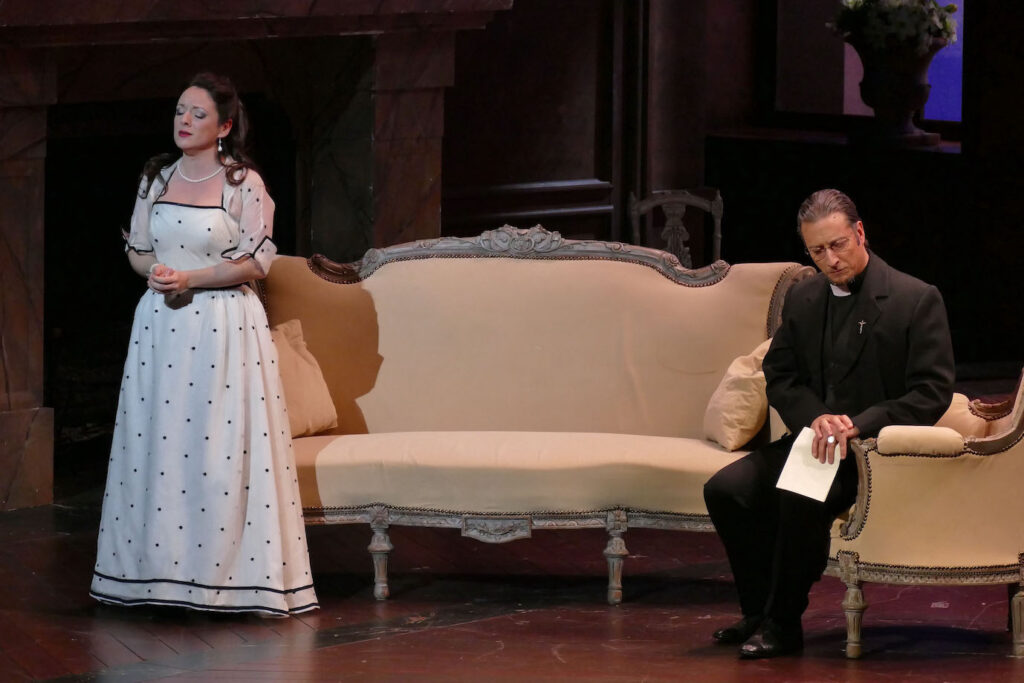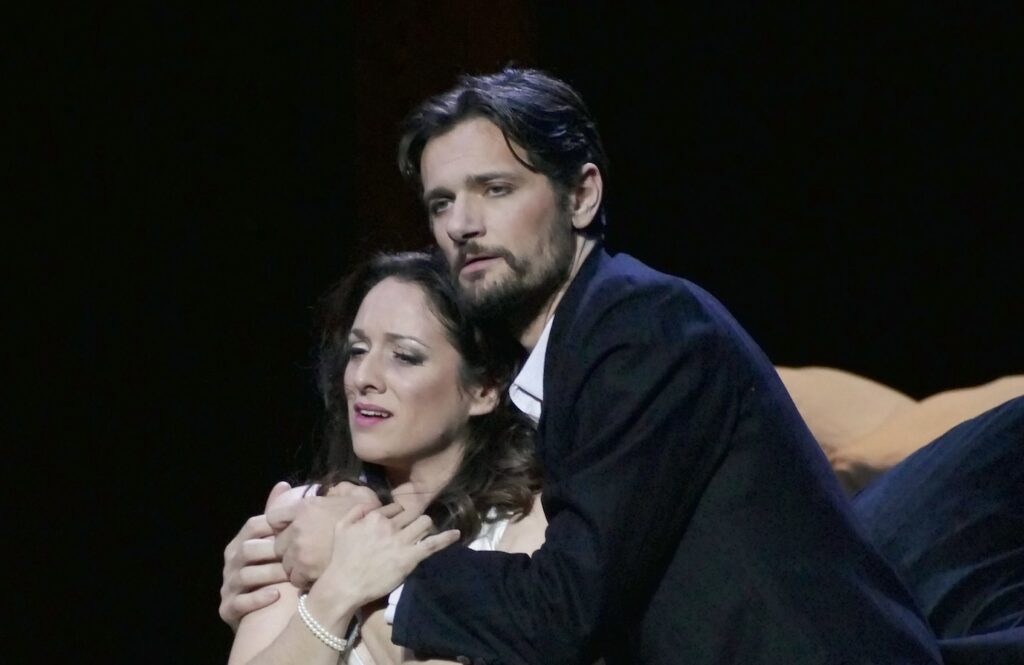Three fine singers saved Marseille Opéra’s recent 5 performance run of La traviata. Marred by a bizarre pit and weird staging conceits, Verdi’s middle period masterwork emerged, in spite of it all, in its indestructible, awesome, bel canto glory.
Spanish soprano Ruth Iniesta brought a bright, silvery sound to Violetta, finding surprising musical and vocal detail in exposing the heroine’s complex emotions. This formidable artist is in mid career — Verdi’s Violetta is one of her signature roles, others are Puccini’s Liu and Bizet’s Micaela. Hers is a Violetta who projects youthful innocence, not the weariness of a worldly courtesan. “Sempre libera” offered Mme. Iniesta the opportunity to find joyous pleasure in her roulades, and to indulge in an immature boast with the famed high E-flat interpolation squarely, forcefully hit, then held a trifle too long (see lead photo). Her mid and lower voice have great warmth, endowing her Violetta to capitulate to Germont and finally to die with frank, girlish innocence
French tenor Julien Dran brought well-studied stylistic pizazz to his performance as Alfredo. He read as a boyish, immature Alfredo just finding his way into the Parisian beau monde, rather than as a jaded ladies’ man finding his way out of it. Mr. Dran has a quite beautiful, lyric voice, often assigned secondary roles on many European stages while continuing to shine in principal roles in Marseille.
Germont was sung by French baritone Jérôme Boutillier. Mr. Boutillier boasts a fine and powerful voice of golden color. It is well focused and very present giving his Germont a youthful sound that belies the mature gravity that is normally associated with the role. Thus he rendered his scenes with Violetta and Alfredo as a singer making beautiful sounds rather than as a concerned father. While this certainly distracted from Verdi’s storytelling, it did meld musically with the innocence of the voices of Violetta and Alfredo, creating Verdi’s bel canto world, if not his theatrical world.

For the 2014 premiere of this mise en scène by Renée Auphan, Opéra de Marseille’s general director Maurice Xiberras engaged a young female conductor, Eun Sun Kim. This Korean maestra has since become the music director of San Francisco Opera. Please see my review of this splendid Marseille opera performance: https://www.michaelmilenski.com/review-archives.html#Traviata_Marseille
Just now Mr. Xiberras entrusted the assistant conductor of the Opéra de Marseille’s orchestra, Naples born maestra Clelia Cafiero to preside musically over the production. This young maestra imposed erratic, changing tempos that prevented Verdi’s longer periods from finding shape. She imposed disturbing and silly rhetorical interruptions to mark brief musical moments she chose to elaborate, naively ignoring the larger dramatic impetus of a scene. As well she confused leading her singers with following her singers, and then in softened accompaniment. The maestra’s conducting thus eviscerated the powerful dramatic thrust that marks Verdi’s middle period operas.

This 2014 Opéra de Marseille production was re-staged just now by Yves Coudray, straying from Renée Auphan;s original intensions that were based on a close reading of the Alexander Dumas fils novel La Dame aux camélias. Mr. Coudray’s staging was instead very straight forward, eliminating Mme. Auphan’s Annina elaboration as a lesbian companion to Violetta, and portraying Flora as an older, former prostitute, the two primary examples. The notable clumsiness of stage movement was perhaps exacerbated by the lack of musical thrust from the pit.
There were two strange episodes of pit silence when voices on-stage were left unaccompanied while off-stage revelry was accompanied by a backstage orchestra. The sound seemed to be, however, a strangely muffled recording rather than real instruments.
Mr. Coudray’s third act Flora recreated an amusing take-off of La Bohème’s second act Musetta shoe episode. There was suggestive interplay between Flora and the Marchese d’Obigny, sung by Frédéric Cornille. If was apparent that the production’s Flora, performed by Laurence Janot, was cast as a shapely dancer rather than as a singer. Alfredo’s friend Gastone was sung by Carl Ghazarossian, a man of many greater years than Alfredo. Alfredo’s rival, the Baron Douphol was sung by a rough voiced Jean-Marie Delpas.
The settings for this 2014 mise en scène were designed by Christine Marist. It is a unit set of three walls, a back wall with three large openings that were plugged differently for each act while the stage right wall had a monumental fireplace that remained in place for all four acts. With the studied lighting of the 2014 staging the set well served the richness of Mme. Auphan’s staging. Lacking that richness these four set elements were a cumbersome reminder that economies may become noticeably heavy-handed. The perfunctory period costumes were designed by Katia Duflot.
Michael Milenski
Opéra de Marseille, Marseille, France, February 15, 2024. All photos copyright Christian Dresse, courtesy of the Opéra de Marseille.